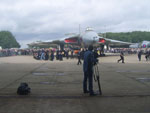 Vulcan at rollout, end of August 2006
The engineering crew gathered for their photo in front of the Vulcan after the necessary £1.2 million had been raised to keep the project running.
Taken by: Charles Toop
Vulcan at rollout, end of August 2006
The engineering crew gathered for their photo in front of the Vulcan after the necessary £1.2 million had been raised to keep the project running.
Taken by: Charles Toop
Following RAF service spanning more than three decades, Avro Vulcan XH558 finally retired from active service in 1992. Designed in 1948 by Roy Chadwick, and capable of reaching speeds of up to 645mph, the Vulcan was a key part of Great Britain's nuclear deterrent in the Cold War era, and also served as maritime reconnaissance, air-to-air refueller and, finally, as the Vulcan Display Aircraft for six years from 1986. The aircraft left its RAF Waddington base in 1993, bound for Leicestershire where she was immediately hangared, after having being saved from destruction by the Walton family who own Bruntingthorpe Airfield.
That was not the end of the Vulcan, however. Growing out of an initial idea put forward by Robert Pleming, the Vulcan to the Sky project was born. Robert gained his Doctorate at the Department of Nuclear Physics at Oxford University and after a successful career in IT with IBM, he moved to become the UK Technical Director for Cisco Systems in 1994.
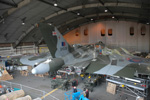 The Vulcan hangar during restoration work in Mid 2007 Taken
by: Kevin Stone
The Vulcan hangar during restoration work in Mid 2007 Taken
by: Kevin Stone
As an air cadet in 1968, Robert gained an RAF Flying Scholarship, and soloed in a Cessna 152 at Luton Airport. In the mid-'90s, a conversation with David Walton, owner of the recently grounded Avro Vulcan XH558, sparked the idea of putting together a formal proposal for the return of the awesome Vulcan to flight. Robert then built a team of expert advisors to investigate what needed to be done, and to guide the project's direction. This approach established sufficient credibility with British Aerospace and the Civil Aviation Authority for the decision to be taken to proceed with the activities necessary to start the return to flight process.
In April 2000, with technical feasibility proved and the decision from British Aerospace to support the project, Robert moved on voluntarily from his Cisco career to the full-time unpaid role of Project Director for what was then the Avro Vulcan XH558 Plan-to-Flight Project.
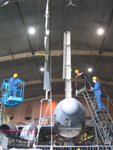 Rudder being fitted Taken
by: Kevin Stone
Rudder being fitted Taken
by: Kevin Stone
Since that time Robert has worked to bring the Vulcan to the Sky engineering project to the position in which it stands today, and his experience and lifelong enthusiasm for aviation have contributed to ensuring the successful return-to-flight for this historic aircraft.
The long awaited take-off for XH558 was the culmination of two and a half years worth of hard work, and over six million pounds worth of investment. Over half of this funding has come from the general public, in the form of donations, the activities of the Vulcan to the Sky Club, and over 22,000 Friends of the Trust. Fully behind the vision to see the Vulcan airworthy again, the Club has regularly spearheaded numerous initiatives to bring in cash to cover the cost of the ongoing engineering work, and led a very successful appeal to save the project from collapse in August 2006, when spiralling costs threatened to halt it. After a massive media drive, the necessary total of £1.2 million was raised through public donations and an astounding £500,000 contribution from Sir Jack Haywood, past owner of Wolverhampton Wanderers Football Club.
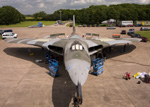 Refuelling Taken
by: Jim Dooley
Refuelling Taken
by: Jim Dooley
A further £2.7 million came from the Heritage Lottery Fund, which subsequently led to the development of the Vulcan education programme, aimed at telling the story of the Cold War in the presence of one of the period's most definitive icons.
With support from BAE Systems (formally British Aerospace), many other aerospace companies and the Heritage Lottery Fund grant, the Vulcan to the Sky Project was born, and engineering work began in earnest with a dedicated team of 30 engineers in August 2005.
Now, as the last Vulcan in the world capable of being restored to full flight status, XH558 has become the focus of one of the largest and most complex aircraft restoration projects ever undertaken. Restoration work on the aircraft has included a total overhaul including the rewiring of electric cabling (totaling over 12 miles and weighing over one ton), the installation of refurbished flying controls, and new piping for its pneumatic and hydraulics systems. Corrosion has been removed from the aircraft’s structure, and the rear spar strengthened - as it was this lack of “Modification 2222” that led to the aircraft's retirement from active RAF service. Fourteen fuel tanks have also been re-installed along with four Rolls-Royce Olympus 202 engines, and a modern new avionics suite and modern navigation aids such as GPS.
 The morning of First Flight Taken
by: Gavin Kemp
The morning of First Flight Taken
by: Gavin Kemp
Other work on the project has seen fuel tank testing and successful engine testing when the four Rolls Royce engines were cranked up to the max to produce eight-and-a-half tons of thrust each. A number of ground runs to check refitted components also saw the Vulcan frequently leave the hangar in recent months, as engineers checked the success of repair work on components which registered minor faults during routine checks. It has been these occasional fault diagnoses and rectifications that have delayed the Vulcan's route to first flight, but with safety as a main concern and with the team adamant that no corners be cut, getting to the point where the Vulcan is ready for take-off has taken much longer than originally planned.
 Take off Taken
by: Jim Dooley
Take off Taken
by: Jim Dooley
Ground tests at the end of September, however, confirmed that all of these last snags had been fixed and that all of XH558's systems worked to specification, giving it the technical go ahead for flight. Not forgetting the bodywork as well, the Vulcan had the special treat of a good wash; the first time in a year since the media roll out in August 2006.
After the success of engineering, paperwork took over as the main focus of the project with a drive to log the restoration process and to verify the auditability of XH558's return back to an airworthy state. With the Civil Aviation Authority happy, the Flight Test Readiness Review opened the way to first test flight.
 In flight Taken
by: Jim Dooley
In flight Taken
by: Jim Dooley
This long awaited event took place on 18th October when the test flight crew, airfield facilities and glorious sunny weather all came together, as well as partners and close friends of the project and a large contingent of representatives from the broadcast media and national press to witness the momentous occasion of the Vulcan take-off. It was a huge milestone for all involved in the project and a fabulous finish to the many thousands of hours of hard work dedicated to getting the aircraft back to its original flight capability.
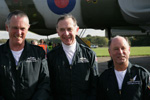 The pilots Al McDicken, David Thomas and Barry Masefield Taken
by: Gavin Kemp
The pilots Al McDicken, David Thomas and Barry Masefield Taken
by: Gavin Kemp
Following on from this successful event, The Vulcan to the Sky Trust believes that opportunities for commercial sponsorship will be unlocked to fund the future of the Trust, as an estimated £1.6 million a year will be needed in order to keep the Vulcan flying. Into the future, it is planned that the Vulcan will be the centrepiece in a travelling education programme, taking the Cold War story all over the country and after 10 to 15 years of display flying, it will finally retire to a National Aviation Museum. In order for the Vulcan's longterm success and to ensure all these plans are realised however, continued public donations will remain vital.
Highlights of the project throughout the overhaul process have included a visit from former Prime Minister Margaret Thatcher, and the Vulcan crews who carried out the successful “Black Buck One” mission to bomb Port Stanley airfield during the Falklands War. And more recently, the project has also benefited from the support of Subaru, in the form of vehicles to transport men and equipment, and Air BP, which has donated a substantial amount of fuel to keep XH558 airborne.
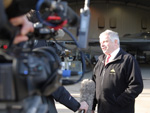 Chief Executive Dr Robert Pleming on the day of first flight
being interviewed by British television. Taken
by: Gavin Kemp
Chief Executive Dr Robert Pleming on the day of first flight
being interviewed by British television. Taken
by: Gavin Kemp
Now, with the goal of first flight achieved, the Vulcan to the Sky Trust can proudly look back at its success, and know that exceptional strength, skill and determination has enabled it to achieve wonderful engineering results for itself and for the UK. The efforts of the Vulcan to the Sky team have promoted the Avro Vulcan as an inspirational part of British aviation history, and have given the aircraft the increased recognition that she rightfully deserves. It is hoped now, that with its second phase of life ahead, the Vulcan will continue taking-off all around the country for many years to come.